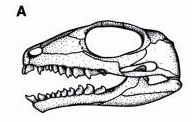
| Palaeos |  |
Anapsida |
| Vertebrates | Bolosauridae |
| Page Back | Unit Home | Unit Dendrogram | Unit References | Taxon Index | Page Next |
| Unit Back | Vertebrates Home | Vertebrate Dendrograms | Vertebrate References | Glossary | Unit Next |
|
Abreviated Dendrogram
REPTILIOMORPHA |--SYNAPSIDA `--+--EUREPTILIA | ANAPSIDA |--+--Millerettidae | `--Eunotosaurus |--Mesosauridae `--+--Lanthanosuchoidea `--+--Bolosauridae | |--Belebey | |--Bolosaurus | `--Eudibamus `--Procolophonia |--Nyctiphruretus `--+--+--Nycteroleteridae | `--Pareiasauridae `--Procolophonoidea |?--TESTUDINES |--Owenettidae `--Procolophonidae |
Contents
Overview |
The Bolosauridae were one of several lines of distinctive small, lizard-like Permian anapsids. They are also the earliest known anapsids, as far as the current fossil record goes. were widely distributed across Laurasia (low and middle latitude Northern Pangea) during the early and middle Permian but do not seem to have survived the End-Gaudalupian mass-extinction, or extended to the high latitudes. As well as being herbivorous with specialised bulbous teeth, they seem to have been capable of short bursts of bipedal running, although for the most part they would have moved in a sprawling posture. The two illustrations above show the two postures. MAK
Two representations of bolosaurids:
 |
 |
| As a biped. Life reconstruction of Eudibamus cursoris by Arthur Weasley - Wikipedia, based on Berman et al. (2000). | As a quadraped. Life reconstruction of Belebey vegrandis, illustration by Dmitry Bogdanov - Wikipedia. |
There is no reason why both of these explanations may not be correct, nor why eiethr species shown here could not be both faculative bipeds as well as quadrapeds
(illustrations GNU Free Documentation/Creative Commons Attribution Share Alike
Bolosauridae: Eudibamus & co.
Range: Early to Middle Permian of Nth Am, Germany, Russia, and China.
Phylogeny: Procolophonomorpha : Lanthanosuchoidea + (Procolophonia ) + * : Belebey + Bolosaurus + Eudibamus).
Characters: Palate without teeth; transverse flange of pterygoid in same plane as palate; dentary and surangular form tall coronoid process; proximal portion of dentary covered by anterior process of prearticular; bulbous, occluding teeth; temporal fenestra long and low, between jugal and squamosal dorsally and quadratojugal ventrally; herbivorous. ATW
Links: Basal Anapsida after Berman et al., 2000, Lee, 1993, 1996 and Modesto 1999, 2000 (dendrogram); Bolosaurus - All About Reptiles (Best on the Web)
References: Berman et al. (2000).
 Belebey B. vegrandis Ivachnenko, 1973 (type); B. maximi Tverdochlebova, 1987; B. chengi Müller 2008. Horizon, locality, and size for B. vegrandis (illustrated right)
Belebey B. vegrandis Ivachnenko, 1973 (type); B. maximi Tverdochlebova, 1987; B. chengi Müller 2008. Horizon, locality, and size for B. vegrandis (illustrated right)
Range: Middle Permian of Russia (several species) and China B. chengi
Phylogeny: Bolosauridae ::: *
Horizon: Belebey Svita, Upper Kazanian
Locality: Krymskii, Orenberg region, South Cis-Urals, European Russia
Length (skull): about 6.5 cm
Age: Roadian to Early Wordian
Comments: Belebey (known from several species, although some of these may be synonymous) and Davletkulia gigantea (known from a single large tooth) were small terrestrial lizard-like animals that seem to have been reasonably common in the Kazanian. It is not known wherther they were faculatively bipedal like Eudibamus. Belebey vegrandis is the best known bolosaur from Eastern Europe. As the name indicates, it is named after the Belebey Svita (formation) where its fossil remains have been found. Similar material has been found in China, indicating the wide distribution of the group.
References: Modesto and Rybczynski 2000, V.P. Tverdokhlebov et. al. 2005
Links: Permian Triassic localities (spreadsheet)
 Bolosaurus: B. striatus Cope, 1878 (Type); B. grandis Reisz, Barkas & Scott, 2002,
Bolosaurus: B. striatus Cope, 1878 (Type); B. grandis Reisz, Barkas & Scott, 2002,
Range: Early Permian (Artinskian and Kungurian) of Nth Am
Phylogeny: Bolosauridae ::: *
Comments: A long-ranging herbivore with bulbous teeth and synapsid-like temporal openings. The Kungurian (Mitchelcreekian LVF) B. grandis is larger and more derived than the Sakmarian/Artinskian to earliest Kungurian (Coyotean-Seymouran LVF) B. striatus and may represent an ancestor-descendent lineage (Lucas 2006 p.78)
Links: Bolosaurus grandis - Permian Tetrapods
References: Watson, 1954 Lucas 2006
Graphic: Derawing of skull by Ghedoghedo - Wikipedia
MAK091129
 Eudibamus: E. cursoris Berman, Reisz, Scott, Henrici, Sumida & Martens 2000
Eudibamus: E. cursoris Berman, Reisz, Scott, Henrici, Sumida & Martens 2000
Range: Early Permian (Artinskian) of WEur (Tambach Formation, Upper Rotliegend, in the Bromacker quarry locality of the middle part of the Thuringian Forest
Phylogeny: Bolosauridae ::: *
Length (overall): about 25 cm
Comments: along with Bolosaurus, this is the oldest known representative of the Anapsida. Both animals appear at about the same time.
Links: Dinosaur News: Eudibamus -ZoomDinosaurs.com; Early Permian Bipedal Reptile article in Science 11-3-00; PALEONTOLOGIA Correndo veloci nel passato (Italian); Reisz Lab: Bromacker Locality.
References: Berman et al. (2000).
Image and Note: Eudibamus cursoris from the Eary Permian of Germany, is the earliest known biped. Berman et al. reconstruct Eudibamus as a cursorial form. The image (a) shows a possible alternate reconstruction as saltorial. Berman et al. reject an arborial clinging & jumping habit because the penultimate phalanges are not elongated as in other organisms with this locomotor style. However, no other cursor or jumper has the primitive tarsal structure of Eudibamus. Accordingly, it may not be entirely safe to rely on such comparisons. Eudibamus has the short neck of a jumping form, although the pelvis is so slight as to make either running or jumping questionable. ATW010416.
| Page Back | Unit Home | Page Top | Page Next |
checked ATW040118, this page MAK120323